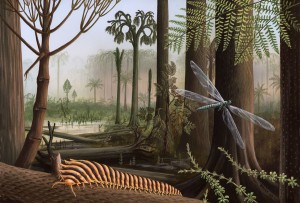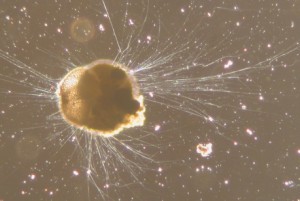Yesterday, I was talking with a friend about politics and evolution. He asked, “Creationism is pretty harmless, though, right? It doesn’t really hurt anyone.”
I suppose for most people, the question “Do you believe in evolution?” seems to matter about as much as the question, “Do you believe in Bigfoot?” Bigfoot might be there, or he might not be, but whether he is or isn’t doesn’t make much difference in their lives. But even though most people may not think about this issue much, I think Creationism does hurt people, and in two main ways. First, evolutionary theory has many practical applications for all sorts of different topics: geology, medicine, agriculture, economics, advertising, mate choice, and pretty much anything else that has anything to do with biology. A proper understanding of evolution can help people make better decisions regarding all sorts of practical matters. Creationism hurts people by closing their minds to this useful information. Second, evolutionary theory opens the doors to a profound and beautiful view of the world. Creationism hurts people by robbing them of a deeper understanding of what the world is, and how it came to be.
By Creationism, I mean the belief that God created the world suddenly, pretty much as it is now, some time in the recent past. This is different from, say, theistic evolution, advocated by people like the great dinosaur scientist Robert Bakker (who apparently is also a Pentecostal preacher). Advocates of theistic evolution accept scientific evidence that the world is very old and has come into its present form through billions of years of gradual changes. (I’m not a religious person myself, but can see how theistic evolution would be an attractive and reasonable view for many people who are religious.)
As an example of where the practical and poetic sides of evolution meet, think of the southern shore of Lake Michigan, where the Indiana Toll Road passes through the huge industrial wastelands of Gary: the grim, depopulating city to the south, the smokestacks, blast furnaces, and slag heaps to the north, mile after mile of rustbelt ruins littering the shores of an inland sea. The steel industry made Gary a boomtown, and the industry’s decline has left it a husk. But some of the factories are still working, and they depend for their work on key three main ingredients: iron, coal, and limestone. Factories make steel by smelting iron in blast furnaces with coke (a purified form of coal) and limestone. The burning coke melts the iron and provides carbon, which combines with the iron to make steel. Limestone removes impurities from the iron, resulting in slag. Gary provides a convenient place for steel factories because it lies close to sources of coal (Illinois) and limestone (Indiana), and is connected by the Great Lakes to a major source of iron (Minnesota).
the grim, depopulating city to the south, the smokestacks, blast furnaces, and slag heaps to the north, mile after mile of rustbelt ruins littering the shores of an inland sea. The steel industry made Gary a boomtown, and the industry’s decline has left it a husk. But some of the factories are still working, and they depend for their work on key three main ingredients: iron, coal, and limestone. Factories make steel by smelting iron in blast furnaces with coke (a purified form of coal) and limestone. The burning coke melts the iron and provides carbon, which combines with the iron to make steel. Limestone removes impurities from the iron, resulting in slag. Gary provides a convenient place for steel factories because it lies close to sources of coal (Illinois) and limestone (Indiana), and is connected by the Great Lakes to a major source of iron (Minnesota).
We owe coal, limestone and iron to three key evolutionary events: the invention of trees, shells, and plants.

The most recent of these is the invention of trees, which resulted in the formation of coal. The coal in Illinois formed during the Pennsylvanian period, just over 300 million years ago, when what is now Illinois was covered by vast, low-lying tropical rainforests. We know from fossils preserved in coalmines that these forests looked unlike any living forests. They had giant club mosses and tree ferns and all sorts of huge versions of plants that survive today only as small forms living in the shadows of more modern trees. These plants were able to grow so tall thanks to a newly evolved fiber, lignin, which they used to make strong, woody stems. In addition to helping the trees grow tall, lignin toughened their bark and protected them from insects, which could not digest the tough fiber. Neither could any of the bacteria or fungi that existed then. As a result, when these trees died, instead of rotting, they piled up and gradually turned into coal. As a result of all this accumulating carbon, the atmosphere developed a growing surplus of oxygen – which may explain the evolution of giant insects and other arthropods, including dragonflies with wingspans two feet wide and millipedes six feet long. Our very distant ancestors, early amphibians, crept and swam about in these swampy forests.

The invention of shells occurred much earlier, shortly before the Cambrian period, which started around 543 million years ago. We don’t know much about life before the invention of shells, because animals without hard parts don’t fossilize very well. But once shells were invented, we get lots and lots of fossils – including huge beds of limestone, made almost entirely from the shells of tiny animals, especially foraminifera: single-celled amoebas that live in tiny shells called tests. Indiana limestone was laid down in the Mississippian period, around 335 million years ago. At the time, a vast shallow sea covered much of Indiana. As tiny marine organisms died, they rained down to the bottom of the sea, their shells contributing bit by bit to what would eventually become limestone.
The invention of plants – or more precisely, photosynthesis – occurred even earlier, and had a profound effect on life on earth. The first creatures to capture sunlight to make food were bacteria. Eventually some of these, such as blue-green algae, developed a method of photosynthesis that produced oxygen as a waste product. At the time, oxygen was poisonous to most living things. As the oxygen waste built up in the atmosphere, some species evolved ways to deal with the poison, but most went extinct, or survived as refugees in crannies hidden from the deadly air. As oxygen dissolved in the sea, it combined with iron compounds already dissolved in the water to make iron oxide (rust), which sank to the bottom and accumulated in layers on the sea floor. The resulting banded iron formations of the Minnesota Iron Ranges are thus the result of biological activity some 2,000 million years ago.

Evolution is not just some story. It’s the explanation for how we get iron, limestone and coal. Without an understanding of evolution, we wouldn’t know where to look for these minerals – or other fossil formations, like oil. Knowing about evolution helps us understand that our supply of these fossil resources, however large, is ultimately limited. And without the glacial lakes formed at the end of the last Ice Age some 10,000 years ago, we would have a much harder time getting the iron from Duluth to Gary.
I love that you’re blogging daily. Although you’re addressing a somewhat different question, I think aspects of your post (perhaps intentionally) suggest an answer for why so many people like to believe in creationism or, especially, “intelligent design”: I think it’s very hard to talk about evolution without attributing some kind of agency. Either nature did it, or the species themselves did it, or the creator did it, but somehow plants were “invented,” shells were “invented,” etc. Linguistically, we may not have many good constructs for talking about things arising evolutionarily – we can say “evolved,” but that gets a bit repetitive, seems circular, and still might be consistent with the possibility that the species had some kind of agentive role (i.e. “trees evolved” is syntactically parallel with “trees grew”).
On a slightly different note, while I like the way you tie in evolution to Gary, there are some other more potent examples for why believing in creationism or, more specifically, not accepting and therefore not understanding evolution, is harmful. For example, people who do not understand evolution do not understand how drug-resistant pathogens and pesticide-resitant weeds and insects develop, leading to over-use of pesticides and antibiotics, with predictable (to evolutionists) results.
A very readable history of Middle Earth, Michael. You lost me on the conclusion, though. How is EVOLUTION the explanation for how we get iron, limestone and coal? You’re talking geology here, not evolution, since you describe epochs and earth chemistry in which certain critters were responsible for depositing these ingredients in certain strata. I would understand evolution theory to explain how those critters got INTO those epochs to do their dirty work.
Alex — glad you’re enjoying the blogs. It’s great to have your thoughtful comments!
To your first point — yes, we don’t have very good language for talking about how natural selection works, because it accomplishes things that seem purposive, goal-oriented and intentional without any mind or plans of its own. It’s much easier to write using short-hand terms like “invented,” but of course I don’t mean intentional, conscious invention here.
To your second point — yes, drug resistance and pesticide resistance are excellent examples of evolution in action today. But I think most Creationists are happy to concede that species can change a little bit over time — micro-evolution without the macro-evolution. After all, we have different breeds of dogs, cats, corn, roses, tulips and so on. Some things I hoped to highlight with the iron, limestone and coal examples are (1) evolutionary events that happened in deep time (hundreds or thousands of millions of years ago) have important economic impacts for us today and (2) these events involved major transitions, not just minor modifications. Photosynthesis, and then the oxygen-producing pathway for photosynthesis, were both major biochemical revolutions — and the latter was a huge catastrophe for nearly every other lifeform on the planet (though of course a huge benefit for us today). The origins of trees and shells were also both huge transitions that impacted the planet on a geological scale. Plus I was just blown away when I found out (just a few years ago) that the iron mines I’d been visiting since I was a kid were the result of biological activity.
Bram, one of the points I was trying to make here is that geology is closely tied to biology. Huge masses of rock, like deposits of limestone, coal, and iron, exist because of biological activity hundreds of millions of years ago. And these particular geological features are tied to key evolutionary changes. The evolution of photosynthesis, for example, was a huge change in the history of life. Before that, living things had to get energy from chemical sources, like hydrogen sulfide. There are still bacteria living in hostile environments like deep sea vents that make their living this way. It took hundreds of millions of years of evolution for living things to evolve ways to capture energy from sunlight. And then, hundreds of millions years later, some bacteria evolved ways to use water in the process — which freed oxygen as a waste product. This proved to be a disaster for almost everything else on the planet at that time, as oxygen was poisonous. This sort of thing is very typical of evolution. Organisms evolve new tricks that benefit themselves in the ongoing competition of life, without regard for the consequences for others. Shells evolved to protect their owners from predators, not to give us limestone. Trees evolved as a way to out-compete other plants, by getting taller and thus out of the shade of other plants, in order to capture more sunlight for photosynthesis. And because trees used a new fiber — lignin — to make their stems strong enough to grow tall, none of the existing insects, fungi or bacteria could digest this new fiber, so when the trees died they accumulated in piles that eventually became coal, rather than rotting away like modern trees do (now that some bacteria and fungi have evolved ways to digest it).
The key point here is that scientists working in lots of different fields — geology, chemistry, paleontology, biochemistry, molecular biology, ecology, and so forth — have gradually revealed a picture of earth history that is astonishingly different from what anyone had previously imagined. Nobody imagined the Ice Ages, or the Dinosaurs, or the Coal Forests, before scientists discovered evidence that they had existed. The earth is very old, and it has changed enormously over time. I think everyone would benefit from learning more about this history.
i love your blog, i have it in my rss reader and always like new things coming up from it.
Thanks so much! I’m glad you’re enjoying it.
What a highly informative, articulate and thoughful blog you carved out from what must be a very limited amount of free time between your family and work obligations- very dazzling indeed.
In many ways of course one will never be able ‘to get them all’ – even with the most rationale and convincing set of arguments and facts – some people seem rather set on negating the plain obvious – particular if humankinds most ‘beloved’ irrational/magical outlet called religious believe is in play. The ‘believing’ or not in evolution becomes than part of a larger attitude and unfortunatelly seem to very rapidly to morphe into the fact free /anti-science retoric that is very much en vogue particualr amoung the noveaux concervative crowd here in the US. (Frankly if one whishes one can find some of that amoung us liberals as well.)
Of course we all have to do a better job of selling science and the framework of the scientific methodology to the larger populance. But of course one should not forget that in many ways what we see these days in the broad acceptablity of anti-scientific and almost deliberatly ignorant attitude is also a expected and ‘natural’ responds following decades of destinctly pro-scientific policies. This latest episode in deliberate ignorance will pass as rapidly as previous ones and humankinds overall arch towards more understanding and knowledge is really not in danger at all.
Many thanks! And yes, good points on (i) some people will never be convinced that evolution occurred and (ii) nonetheless, science marches on. I imagine that in another century or two, evolution will be no more controversial for the general public than the Copernican theory of the solar system is today.
I would speculate we are not talking centuries here but rather decade(s).
In many ways evolution in the context we commonly understand it is in my opinion yesterdays “Copernican” controversy – certainly a certain religious crowd will never be able to let go but mainstream is allredy pretty comfortable with all important aspects of evolution.
Due to my scientific exposure and line of work I actually view issues related to the human brain, consciousness, perception etc. as potentially more scary for the average person and our self-understanding as humans- it is one thing to (reluctantly) accept that neither the earth nor the sun are center of the universe it is another to realize that we are just the result of billions of years of evolution The next level in this evolutionary process of selfdiscovery might be to accept that our intelligence, consciousness and the assumption to be able to grasp our very existence and physical surroundings might be limited and a rather beautiful mirage.
I’m a bit more pessimistic about the time frame for general acceptance of evolution. The Scopes Monkey Trial was way back in 1925 but people still try to push Creationism in the schools.
I agree that it’s precisely because evolution, and related work like the studies of the brain that you work on, involve our intelligence and consciousness that they are harder to accept, and even more subversive of prior views of the world, than Copernicus.
And apparently, there’s a growing movement among Catholics to revive the view that the earth is, in fact, the center of the universe